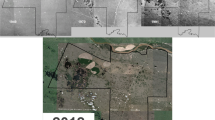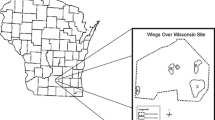Abstract
Understanding plant community change over time is essential for managing important ecosystems such as riparian areas. This study analyzed historic vegetation using soil seed banks and the effects of riparian shrub removal treatments and channel incision on ecosystem and plant community dynamics in Canyon de Chelly National Monument, Arizona. We focused on how seeds, nutrients, and ground water influence the floristic composition of post-treatment vegetation and addressed three questions: (1) How does pre-treatment soil seed bank composition reflect post-treatment vegetation composition? (2) How does shrub removal affect post-treatment riparian vegetation composition, seed rain inputs, and ground water dynamics? and (3) Is available soil nitrogen increased near dead Russian olive plants following removal and does this influence post-treatment vegetation? We analyzed seed bank composition across the study area, analyzed differences in vegetation, ground water levels, and seed rain between control, cut-stump and whole-plant removal areas, and compared soil nitrogen and vegetation near removed Russian olive to areas lacking Russian olive. The soil seed bank contained more riparian plants, more native and fewer exotic plants than the extant vegetation. Both shrub removal methods decreased exotic plant cover, decreased tamarisk and Russian olive seed inputs, and increased native plant cover after 2 years. Neither method increased ground water levels. Soil near dead Russian olive trees indicated a short-term increase in soil nitrogen following plant removal but did not influence vegetation composition compared to areas without Russian olive. Following tamarisk and Russian olive removal, our study sites were colonized by upland plant species. Many western North American rivers have tamarisk and Russian olive on floodplains abandoned by channel incision, river regulation or both. Our results are widely applicable to sites where drying has occurred and vegetation establishment following shrub removal is likely to be by upland species.







Similar content being viewed by others
References
Bay RF, Sher AA (2008) Success of active revegetation after Tamarix removal in riparian ecosytems of the southwestern United States: a quantitiative assessment of past restoration projects. Restor Ecol 16(1):113–128
Berlow EL, D’Antonio CM, Swartz H (2003) Response of herbs to shrub removal across natural and experimental variation in soil moisture. Ecol Appl 13(5):1375–1387
Bertrand LJ, Lalonde M (1985) In vitro propagation and nodulation by Frankia of actinorhizal Russian Olive (Elaeagnus angustifolia L). Plant Soil 87(1):143–152
Binkley D, Matson P (1983) Ion-exchange resin bag method for assessing forest soil-nitrogen availability. Soil Sci Soc Am J 47(5):1050–1052
Birken AS, Cooper DJ (2006) Process of Tamarix invasion and floodplain development during the 20th century along the Lower Green River, UT. Ecol Appl 16(3):1103–1120
Bolker BM, Brooks ME, Clark CJ, Geange SW, Poulsen JR, Stevens MHH, White JSS (2009) Generalized linear mixed models: a practical guide for ecology and evolution. Trends Ecol Evol 24(3):127–135
Boudell JA, Stromberg JC (2008) Propagule banks: potential contribution to restoration of an impounded and dewatered riparian ecosystem. Wetlands 28(3):656–665
Brudvig LA, Asbjornsen H (2007) Stand structure, composition, and regeneration dynamics following removal of encroaching woody vegetation from Midwestern oak savannas. For Ecol Manag 244(1–3):112–121
Cadol DD, Rathburn SL, Cooper DJ (2010) Aerial photographic analysis of channel narrowing and vegetation expansion in Canyon de Chelly National Monument, Arizona, USA, 1935–2004. River Res Appl. doi:10.1002/rra.1399
Clarke KR, Gorley RN (2006) PRIMER 6. PRIMER-E Ltd., Plymouth
Cleverly JR, Dahm CN, Thibault JR, McDonnell DE, Coonrod JEA (2006) Riparian ecohydrology: regulation of water flux from the ground to the atmosphere in the Middle Rio Grande, New Mexico. Hydrol Process 20(15):3207–3225
Cooper DJ, Andersen DC (2010) Novel plant communities limit the effects of a managed flood to restore riparian forests along a large regulated river. River Res Appl. doi:10.1002/rra.1452
Crawley MJ (2007) The R book. Wiley, West Sussex, England
DeCant JP (2008) Russian Olive, Elaeagnus angustifolia, alters patterns in soil nitrogen pools along the Rio Grande River, New Mexico, USA. Wetlands 28(4):896–904
Dolle M, Schmidt W (2009) The relationship between soil seed bank, above-ground vegetation and disturbance intensity on old-field successional permanent plots. Appl Veg Sci 12(4):415–428
Friedman JM, Osterkamp WR, Scott ML, Auble GT (1998) Downstream effects of dams on channel geometry and bottomland vegetation: regional patterns in the Great Plains. Wetlands 18(4):619–633
Friedman JM, Auble GT, Shafroth PB, Scott ML, Merigliano MF, Preehling MD, Griffin EK (2005) Dominance of non-native riparian trees in western USA. Biol Invasions 7(4):747–751
Goodson JM, Gurnell AM, Angold PG, Morrissey IP (2001) Riparian seed banks: structure, process and implications for riparian management. Prog Phys Geogr 25(3):301–325
Graf WL (1983) The arroyo problem-paleohydrology and paleohydraulics in the short term. In: Gregory KJ (ed) Background to paleohydrology: a perspective. Wiley, New York, pp 279–302
Gurevitch J, Scheiner SM, Fox GA (2002) The ecology of plants. Sinauer Associates Inc., Sunderland, MA
Harms RS, Hiebert RD (2006) Vegetation response following invasive tamarisk (Tamarix spp.) removal and implications for riparian restoration. Restor Ecol 14(3):461–472
Harner MJ, Crenshaw CL, Abelho M, Stursova M, Shah JJF, Sinsabaugh RL (2009) Decomposition of leaf litter from a native tree and an actinorhizal invasive across riparian habitats. Ecol Appl 19(5):1135–1146
Heleno R, Lacerda I, Ramos JA, Memmott J (2010) Evaluation of restoration effectiveness: community response to the removal of alien plants. Ecol Appl 20(5):1191–1203
Herbel CH, Gould WL, Leifeste WF, Gibbens RP (1983) Herbicide treatment and vegetation response to treatment of mesquites in southern New-Mexico. J Range Manag 36(2):149–151
Hobbs RJ, Higgs E, Harris JA (2009) Novel ecosystems: implications for conservation and restoration. Trends Ecol Evol 24(11):599–605. doi:10.1016/j.tree.2009.05.012
Hobbs RJ, Cole DN, Yung L, Zavaleta ES, Aplet GH, Chapin FS, Landres PB, Parsons DJ, Stephenson NL, White PS, Graber DM, Higgs ES, Millar CI, Randall JM, Tonnessen KA, Woodley S (2010) Guiding concepts for park and wilderness stewardship in an era of global environmental change. Front Ecol Environ 8(9):483–490. doi:10.1890/090089
Holmes PM, Cowling RM (1997) Diversity, composition and guild structure relationships between soil-stored seed banks and mature vegetation in alien plant-invaded South African fynbos shrublands. Plant Ecol 133(1):107–122
Hughes RF, Denslow JS (2005) Invasion by a N-2-fixing tree alters function and structure in wet lowland forests of Hawaii. Ecol Appl 15(5):1615–1628
Jackson ST, Hobbs RJ (2009) Ecological restoration in the light of ecological history. Science 325(5940):567–569. doi:10.1126/science.1172977
Johnson WC (2002) Riparian vegetation diversity along regulated rivers: contribution of novel and relict habitats. Freshw Biol 47(4):749–759
Katz GL, Friedman JM, Beatty SW (2001) Effects of physical disturbance and granivory on establishment of native and alien Riparian trees in Colorado, U.S.A. Divers Distrib 7(1/2):1
Klemmedson JO, Tiedemann AR (1986) Long-term effects of mesquite removal on soil characteristics. 2. Nutrient availability. Soil Sci Soc Am J 50(2):476–480
Marchante E, Kjoller A, Struwe S, Freitas H (2009) Soil recovery after removal of the N-2-fixing invasive Acacia longifolia: consequences for ecosystem restoration. Biol Invasions 11(4):813–823
Martin SC, Morton HL (1993) Mesquite control increases grass density and reduces soil loss in southern Arizona. J Range Manag 46(2):170–175
Minchin PR (1987) An evaluation of the relative robustness of techniques for ecological ordination. Vegetatio 69(1–3):89–107
Nagler PL, Morino K, Didan K, Erker J, Osterberg J, Hultine KR, Glenn EP (2009) Wide-area estimates of saltcedar (Tamarix spp.) evapotranspiration on the lower Colorado River measured by heat balance and remote sensing methods. Ecohydrology 2(1):18–33
R Development Core Team (2010) R: a language and environment for statistical computing. R Foundation for Statistical Computing, Vienna, Austria
Reed PB (1997) Revision of the national list of plant species that occur in wetlands. U. S. Fish and Wildlife Service, Department of the Interior, Washington, DC
Reynolds LV, Cooper DJ (2010) Environmental tolerance of an invasive riparian tree and its potential fo continued spread in the southwestern US. J Veg Sci 21(4):733–743. doi:10.1111/j.1654-1103.2010.01179.x
Richter R, Stromberg JC (2005) Soil seed banks of two montane riparian areas: implications for restoration. Biodivers Conserv 14(4):993–1016
Rink G (2003) Vascular flora of Canyon de Chelly National Monument, Apache County, Arizona. Master’s Thesis, Northern Arizona University, Flagstaff, AZ
Sabo JL, Sponseller R, Dixon M, Gade K, Harms T, Heffernan J, Jani A, Katz G, Soykan C, Watts J, Welter A (2005) Riparian zones increase regional species richness by harboring different, not more, species. Ecology 86(1):56–62
Sala A, Smith SD, Devitt DA (1996) Water use by Tamarix ramosissima and associated phreatophytes in a Mojave Desert floodplain. Ecol Appl 6(3):888–898
Schade JD, Hobbie SE (2005) Spatial and temporal variation in islands of fertility in the Sonoran Desert. Biogeochemistry 73(3):541–553
SCS US (1934) United States Soil Conservation Service Region Eight Records. Center for Southwest Research, University of New Mexico. Albuquerque
Seastedt TR, Hobbs RJ, Suding KN (2008) Management of novel ecosystems: are novel approaches required? Front Ecol Environ 6(10):547–553
Shafroth PB, Cleverly JR, Dudley TL, Taylor JP, Van Riper C, Weeks EP, Stuart JN (2005) Control of Tamarix in the Western United States: implications for water salvage, wildlife use, and riparian restoration. Environ Manag 35(3):231–246
Shafroth PB, Beauchamp VB, Briggs MK, Lair K, Scott ML, Sher AA (2008) Planning riparian restoration in the context of Tamarix control in western North America. Restor Ecol 16(1):97–112
Shafroth PB, Brown CA, Merritt DM (2010) Saltcedar and Russian Olive control demonstration act science assessment: U.S. Geological Survey Scientific Investigations Report 2009-5247
Shah JJF, Harner MJ, Tibbets TM (2010) Elaeagnus angustifolia elevates soil inorganic nitrogen pools in riparian ecosystems. Ecosystems 13(1):46–61
Simberloff D (2005) Non-native species do threaten the natural environment!. J Agric Environ Ethics 18(6):595–607
Stohlgren TJ, Bull KA, Otsuki Y, Villa CA, Lee M (1998) Riparian zones as havens for exotic plant species in the central grasslands. Plant Ecol 138(1):113–125
Stromberg JC (2001) Restoration of riparian vegetation in the south-western United States: importance of flow regimes and fluvial dynamism. J Arid Environ 49(1):17–34
Stromberg JC, Lite SJ, Marler R, Paradzick C, Shafroth PB, Shorrock D, White JM, White MS (2007) Altered stream-flow regimes and invasive plant species: the Tamarix case. Glob Ecol Biogeogr 16(3):381–393
Stromberg JC, Boudell JA, Hazelton AF (2008) Differences in seed mass between hydric and xeric plants influence seed bank dynamics in a dryland riparian ecosystem. Funct Ecol 22(2):205–212
Stromberg JC, Chew MK, Nagler PL, Glenn EP (2009) Changing perceptions of change: the role of scientists in Tamarix and river management. Restor Ecol 17(2):177–186
Tiedemann AR, Klemmedson JO (2004) Responses of desert grassland vegetation to mesquite removal and regrowth. J Range Manag 57(5):455–465
USDA (2010) The PLANTS Database, National Plant Data Center, NRCS. http://plants.usda.gov
Vosse S, Esler KJ, Richardson DM, Holmes PM (2008) Can riparian seed banks initiate restoration after alien plant invasion? Evidence from the Western Cape, South Africa. S Afr J Bot 74(3):432–444
Webb RH, Leake SA (2006) Ground-water surface-water interactions and long-term change in riverine riparian vegetation in the southwestern United States. J Hydrol 320(3–4):302–323
Wentworth TR, Johnson GP, Kologiski RL (1988) Designation of wetlands by weighted averages of vegetation data—a preliminary evaluation. Water Resour Bull 24(2):389–396
Williams L, Reich P, Capon SJ, Raulings E (2008) Soil seed banks of degraded riparian zones in southeastern Australia and their potential contribution to the restoration of understorey vegetation. River Res Appl 24(7):1002–1017
Acknowledgments
Funding was provided by the US National Park Service (NPS), with additional funds from the Program for Interdisciplinary Mathematics, Ecology and Statistics at Colorado State University (National Science Foundation award #DGE-0221595003). We thank Joel Wagner, Scott Travis, and Elaine Leslie of the NPS, and all the Canyon de Chelly staff for logistical support. We also thank Kris Jaeger, Laurie Gilligan, Renee Petipas, Tara and Farrah Deschine, Frankie Coburn, Jeremiah Barber, Jesse Mike, Nathan Cooper and Emily Nash for tireless field support. Thanks also to Drs. Phil Chapman and David M. Merritt for advice on statistical analyses.
Author information
Authors and Affiliations
Corresponding author
Appendix: species lists for vegetation and soil seed bank surveys in Canyon de Chelly National Monument
Appendix: species lists for vegetation and soil seed bank surveys in Canyon de Chelly National Monument
Rights and permissions
About this article
Cite this article
Reynolds, L.V., Cooper, D.J. Ecosystem response to removal of exotic riparian shrubs and a transition to upland vegetation. Plant Ecol 212, 1243–1261 (2011). https://doi.org/10.1007/s11258-011-9901-7
Received:
Accepted:
Published:
Issue Date:
DOI: https://doi.org/10.1007/s11258-011-9901-7




